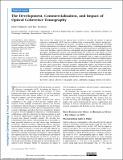| dc.contributor.author | Fujimoto, James G | |
| dc.contributor.author | Swanson, Eric A | |
| dc.date.accessioned | 2017-06-16T22:45:03Z | |
| dc.date.available | 2017-06-16T22:45:03Z | |
| dc.date.issued | 2016-07 | |
| dc.date.submitted | 2016-05 | |
| dc.identifier.issn | 1552-5783 | |
| dc.identifier.uri | http://hdl.handle.net/1721.1/109995 | |
| dc.description.abstract | This review was written for the special issue of IOVS to describe the history of optical coherence tomography (OCT) and its evolution from a nonscientific, historic perspective. Optical coherence tomography has become a standard of care in ophthalmology, providing real-time information on structure and function – diagnosing disease, evaluating progression, and assessing response to therapy, as well as helping to understand disease pathogenesis and create new therapies. Optical coherence tomography also has applications in multiple clinical specialties, fundamental research, and manufacturing. We review the early history of OCT describing how research and development evolves and the important role of multidisciplinary collaboration and expertise. Optical coherence tomography had its origin in femtosecond optics, but used optical communications technologies and required advanced engineering for early OCT prototypes, clinical feasibility studies, entrepreneurship, and corporate development in order to achieve clinical acceptance and clinical impact. Critical advances were made by early career researchers, clinician scientists, engineering experts, and business leaders, which enabled OCT to have a worldwide impact on health care. We introduce the concept of an “ecosystem” consisting of research, government funding, collaboration and competition, clinical studies, innovation, entrepreneurship and industry, and impact – all of which must work synergistically. The process that we recount is long and challenging, but it is our hope that it might inspire early career professionals in science, engineering, and medicine, and that the clinical and research community will find this review of interest. | en_US |
| dc.description.sponsorship | National Institutes of Health (U.S.) (R01- EY11289) | en_US |
| dc.description.sponsorship | National Institutes of Health (U.S.) (R01-CA75289) | en_US |
| dc.description.sponsorship | National Institutes of Health (U.S.) (R01-CA178636) | en_US |
| dc.description.sponsorship | United States. Air Force. Office of Scientific Research (FA9550-10-1-0551) | en_US |
| dc.description.sponsorship | United States. Air Force. Office of Scientific Research (FA9550-12-1-0499) | en_US |
| dc.language.iso | en_US | |
| dc.publisher | Association for Research in Vision and Ophthalmology | en_US |
| dc.relation.isversionof | http://dx.doi.org/10.1167/iovs.16-19963 | en_US |
| dc.rights | Creative Commons Attribution 4.0 International License | en_US |
| dc.rights.uri | http://creativecommons.org/licenses/by/4.0/ | en_US |
| dc.source | Association for Research in Vision and Ophthalmology (ARVO) | en_US |
| dc.title | The Development, Commercialization, and Impact of Optical Coherence Tomography | en_US |
| dc.type | Article | en_US |
| dc.identifier.citation | Fujimoto, James, and Eric Swanson. “The Development, Commercialization, and Impact of Optical Coherence Tomography.” Investigative Opthalmology & Visual Science 57, no. 9 (July 13, 2016): OCT1. | en_US |
| dc.contributor.department | Massachusetts Institute of Technology. Department of Electrical Engineering and Computer Science | en_US |
| dc.contributor.department | Massachusetts Institute of Technology. Research Laboratory of Electronics | en_US |
| dc.contributor.mitauthor | Fujimoto, James G | |
| dc.contributor.mitauthor | Swanson, Eric A | |
| dc.relation.journal | Investigative Opthalmology & Visual Science | en_US |
| dc.eprint.version | Final published version | en_US |
| dc.type.uri | http://purl.org/eprint/type/JournalArticle | en_US |
| eprint.status | http://purl.org/eprint/status/PeerReviewed | en_US |
| dspace.orderedauthors | Fujimoto, James; Swanson, Eric | en_US |
| dspace.embargo.terms | N | en_US |
| dc.identifier.orcid | https://orcid.org/0000-0002-0828-4357 | |
| mit.license | PUBLISHER_CC | en_US |
